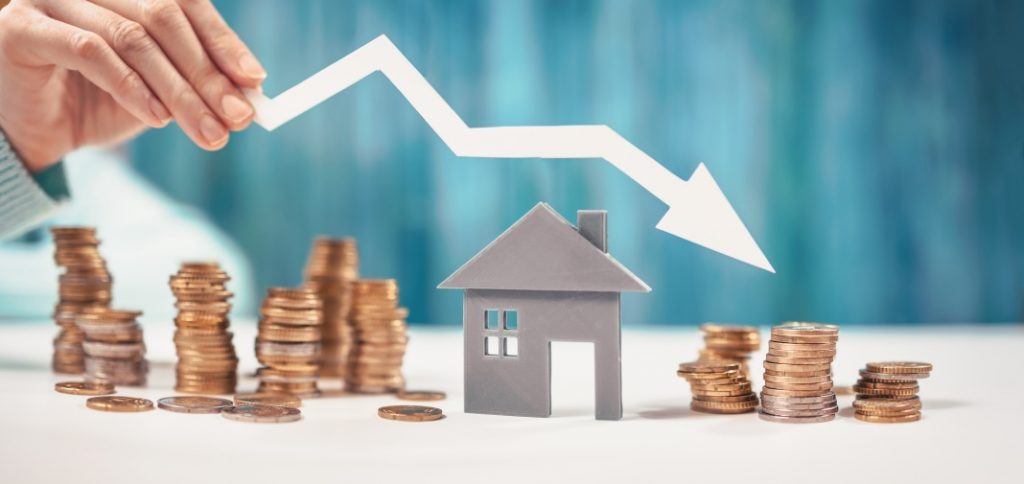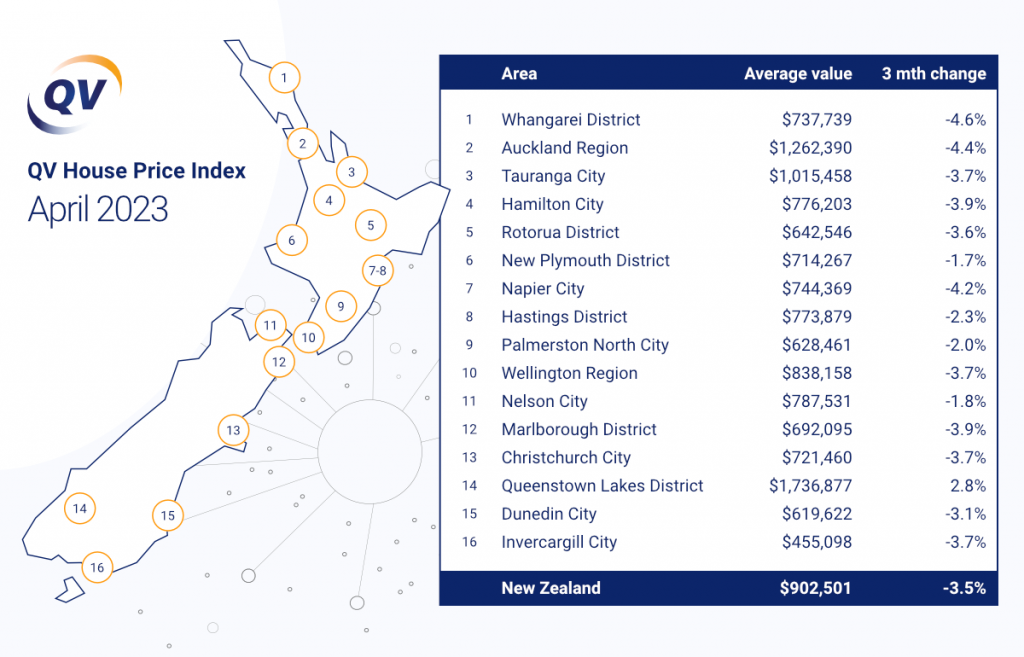While the residential property downturn looks to be nearing its end in some areas, it is still gaining momentum in others, the latest QV House Price Index shows

Values have reduced by an average of 4.5% throughout the first four months of 2023, including an average reduction of 0.6% in the month of April – a marked improvement on the 1.4% average decline recorded back in March. The national average home value is now $902,501, which is 13.3% less than the same time last year, but 22% higher than before the Covid-19 pandemic first began here in late February 2020.
The average rate of home value decline has slowed in 10 of the 16 largest urban areas that QV monitors – including in Auckland, where the rolling three-month rate of reduction has slowed from 5.2% in March, to 4.4% in April. However, it is still the second-largest average home value decline this quarter, after Whangarei (4.6%). Wellington’s average rate of home value decline has also slowed to 3.7% this quarter, down from a 4.8% quarterly decline back in March.
In the South Island, Queenstown was the only one of the country’s main urban centres to record positive home value growth at an average of 2.8% – representing a remarkable turnaround from last month’s quarterly decline of 3.2%. Christchurch (-3.7%) and Dunedin (-3.1%) both recorded notably larger quarterly home value reductions in April than they did back in March (-1.2% and -1.6% respectively), with the former marking its first double-digit annual decline (-10%) in 14 years.
QV national spokesperson Simon Petersen commented: “We’re seeing a mixed bag of results across the country right now, with the residential property downturn slowing in some centres, yet increasing in others. The market fundamentals have not changed – credit constraints and high interest rates continue to have a stranglehold on the market – but we are starting to see some small signs that it could be approaching equilibrium.
“Though it’s still far too early to say precisely when the downturn will bottom out, the Reserve Bank’s recent proposal to ease mortgage loan-to-value ratio (LVR) restrictions, coupled with additional changes to the treatment of expenditure in application processes, could certainly bring some buyers back into play. Immigration is also continuing to ramp up in the background, fuelling demand for housing. These things won’t revitalise the real estate market overnight, but they may provide some relief at a time when activity is at historic low levels.”
Mr Petersen said buyers remained scarce, even as new listings fell to historic lows in April. “Investors are sitting on their hands for the most part, potentially biding their time while they wait to see what this year’s election has in store for them – although continued ‘stalling’ of value declines within some of NZ’s larger urban areas may begin to entice some who believe that we are at the ‘bottom of the curve’ back into the market.
“Owner-occupiers are having to weigh up the considerable challenges and risks of trying to buy and sell in such a difficult market environment. While large numbers of first-home buyers are still being locked out of it altogether due to its unaffordability – the cost of living crisis being a major barrier to saving for a deposit, and then being able to service a mortgage.”
“Meanwhile, the real estate market is continuing on its steady climb back down the mountain of very significant home value growth we saw in 2020 and especially 2021. It’s still a long way off its pre-Covid-19 levels for the most part, but this corrective cycle isn’t over yet – it still looks as though the market is destined for a difficult winter ahead,” he added.

Auckland
The average home value across Auckland is now 15.4% lower than the same time last year at $1,262,390.
The region’s rolling three-month rate of reduction slowed from 5.2% in March to 4.4% in April, with five of the Super City’s former territorial authorities also seeing their rates of reduction reduce. Rodney (-4.2%) and North Shore (-3.5%) were the two exceptions, with Manukau (-5%) recording the largest average reduction in home value (a 1.7% improvement on last month’s figure).
Franklin District managed to buck the downward trend entirely this quarter. Its average home value increased by 1.6% to $932,918.
Despite this, local QV valuer Hugh Robson said it was too early to say whether or not the Auckland market was starting to bottom out. “Auckland’s residential property market continues to be very quiet. We’re seeing low sales volumes, quiet open homes, and extended selling periods.”
“In Waitakere and Auckland’s central suburbs, properties are regularly selling at around 10-15% below their rating values. Buyers are generally paying prices similar to the levels seen in May or June 2021. Developers are just focusing on completing their current developments – very few development sales are taking place at the moment.”
Northland
Whangarei has experienced the largest average home value reduction of New Zealand’s main urban centres for the second month running.
The city’s average home value has gone down by 4.6% to $737,739 in the three months to the end of April 2023 – representing a significant decrease from the 6.6% three-month decline to the end of March. House values are now 13.3% lower on average than they were here one year ago.
Meanwhile, Kaipara District saw an even larger decline in average home value of 8.4% this quarter, with Far North District once again proving to be the most resilient of the north with an average decline of 3.7% throughout the three months to the end of April.
Tauranga
Tauranga’s average rate of house value decline slowed by 0.8% this quarter.
In the three months to the end of April, home values slipped back 3.7% to $1,015,458 – representing a smaller quarterly decline than the 4.5% recorded back in March. Annually, home values are now 14.9% less on average than they were one year ago.
QV property consultant Derek Turnwald commented: “Open home attendance is starting to drop off even more now as we move into the cooler months of the year. Auction attendance remains poor overall, and consequently so are auction outcomes. But properties with maintenance issues or unconsented work are still the most difficult to sell right now.”
However, Mr Turnwald said there were signs that the market’s current “corrective cycle” could be starting to come to an end – including the Reserve Bank’s proposal to relax LVR restrictions, indications that its next Official Cash Rate review could see only a small percentage increase or none at all, increasing migration, and a decreasing supply of new homes coming onto the market.
Waikato
Hamilton’s quarterly rate of home value decline slowed in April.
The city’s average home value reduced by 3.9% to $776,203 in the three months to the end of April 2023 – an improvement on the 5.2% decline recorded over the three months to the end of March. Home values are now 13.3% lower on average than the same time last year, following a relatively strong April that saw values all-but hold even at just a 0.1% decline for the month.
Local QV property consultant Marshall Wu said market sentiment remains relatively downbeat, with no sign of interest rates easing in the near future and the cost of living still increasing. “Agents are reporting longer selling periods with fewer buyers in the market. Sales volumes are significantly lower than 12 months ago, which is understandable given the major shift in market sentiment and conditions. However, easing LVR restrictions will likely benefit first-home buyers.”
Meanwhile, home values have fallen away by an average of 2.9% across the wider Waikato region this quarter. The latest QV House Price Index shows the largest reductions were in Hauraki District (-6.7%) and Waikato District (-4.1%). Otorohanga has largely managed to buck this downward trend, with its average home value still sitting 6.5% higher than the same time last year.
“Regional markets continue to slow down due to the same factors and market conditions that Hamilton and the rest of New Zealand have been experiencing for the last 12 months. All districts in the Waikato region have seen a decrease in median house prices over the past six months, but there are positive signs that Waikato property prices may have started to stabilise in recent months.”
Rotorua
Is the real estate market finally starting to bottom out in Rotorua?
“There are some strong fundamentals which are beginning to indicate that the current corrective cycle of the residential property market could be coming to an end,” said QV property consultant Derek Turnwald.
For one thing, Rotorua’s average home value actually increased by 1.6% to $642,546 in April, compared to an average decline of 0.6% nationally last month. It was enough to improve the city’s rolling three-month rate of decline from 5.7% in March to 3.6% in April.
Mr Turnwald said other signs the current cycle could be coming to an end include the Reserve Bank’s proposal to relax LVR restrictions and indications that its next Official Cash Rate review could see only a small percentage increase or none at all.
“New Zealand is currently experiencing a net migration boom, we still have a tight labour market with strong job security, and the supply of new houses is declining. A lack of commitment from buyers could be partly attributable to it being an election year, so after October there will be more certainty and therefore it’s likely we’ll see more property transactions around that time too.”
Taranaki
Home values in the Taranaki region are on average 2.2% lower than they were at the start of this year, which is less than half the national average (-4.5%).
In New Plymouth, the rolling three-month average rate of home value decline increased from 1.5% in March to 1.7% in April. The average home value is now $714,267, which is 5.8% lower than the same time last year.
In the neighbouring districts of Stratford and South Taranaki home values have reduced by an average of 5.6% and 2.2% respectively this quarter.
Hawke’s Bay
The downturn has picked up a small amount of momentum this quarter in Napier and Hastings.
Napier’s rolling three-month average rate of home value decline increased from 3.8% in March to 4.2% in April. In neighbouring Hastings, the rate of decline increased from 2% in March to 2.3% in April. Annually, home values are now 17.2% and 13.8% lower in Napier and Hastings respectively.
QV Hawke’s Bay manager Damian Hall commented: “Activity is fairly quiet across the board. First home buyers appear to be gradually entering the market again. There is some evidence of investors getting out, potentially due to the pressure of increased interest rates. We are starting to see some flood money enter the market too, particularly in the upper quartile. This doesn’t seem to be impacting prices but merely helping clear out existing stock.”
Meanwhile, values continued to drop across the wider Hawke’s Bay region this quarter at an average rate of 3.6%. Annually, home values are down the most on average in Central Hawke’s Bay District (-20.6%), with Wairoa District still showing a small but statistically significant amount of growth (0.3%).
Palmerston North
The average rate of home value decline slowed in Palmerston North this quarter.
The city’s average home value is now $628,461, which is 14.4% lower than the same time last year. It reduced by 2% during the April quarter, which is an improvement on the 2.7% quarterly rate of decline reported in last month’s QV House Price Index.
Local QV registered valuer Olivia Betts commented: “We continue to see a leveling out within the market. Though demand for residential property remains subdued generally and the number of sale transactions is low.”
“Generally lower-valued properties in Palmerston North are still showing negative movements, while the higher-valued properties are remaining fairly solid at their current levels,” she added.
Wellington
The downturn slowed this quarter in Wellington.
The latest QV House Price Index shows home values reduced across the region by an average of 3.7% throughout the April quarter – still a faster rate than the national average (-3.5%) but well down on the 4.8% average decline for the March quarter. The average home value is now $838,158.
The largest declines this quarter occurred in Porirua (-6.6%), Kapiti Coast District (-5.1%), and Wellington City (-3.4%), despite the latter showing a small but statistically significant amount of home value growth during the month of April (0.2%).
Local QV senior consultant Blake Ngarimu commented: “Although the market has continued to see a decline in values over the first few months of 2023, the stats are showing signs that we may be nearing the bottom.
“Over the month of April the average value in Wellington City has remained relatively stable with a slight increase of 0.2%, values in Lower Hutt decreased by 0.2%, and they decreased by 0.6% in Upper Hutt. Porirua experienced the largest decline of 2.6%, but otherwise it was a relatively stronger month for the region’s housing market.”
He said most active buyers in recent months tended to be first-home buyers. “It’s likely that large numbers of investors will be looking to hold off until after the general election.”
Nelson
Nelson’s average rate of home value decline slowed last month – but it remains a difficult market for buyers and sellers.
The city’s average home value fell another 1.8% this quarter to $787,531, but all-but broke even in April itself (-0.1%). It’s an improvement on the 2.3% decline reported for the March quarter, with the annual average rate of decline now sitting just under double digits at 9.4%.
QV Nelson/Marlborough manager Craig Russell said market activity remained subdued with modest levels of properties transacting. “Conditional contracts remain the order of the day with a number of in-chain sales with purchasers often being conditional on the sale of their own property.”
“We are seeing a clear oversupply of properties in the $900,000 to $1,500,000 bracket in Richmond. Properties that are not being priced to meet the market are becoming stale and tend to result in asking price reductions,” Mr Russell said.
“Investor activity remains low given the high interest rate environment. Softening property values and tax changes are making it difficult for these investments to stack up financially. But we have seen increased activity in the $500,000 to $700,000 price bracket over the past month. With the First Home Grant price caps in the process of being adjusted, we may start to see more activity in this price bracket in the coming months.”
West Coast
The downturn picked up a small amount of momentum this quarter on the West Coast.
Home values have fallen across the region by an average of 2.2% during the April quarter – down from the 1.7% average decline we reported last month for the March quarter.
However, values have reduced by just 3.4% on average since the same time last year, compared to a national average annual decline of 13.3%. Buller (-5.7%) leads the annual decline for the region, with Grey (-2.2%) and Westland (-2.5%) experiencing less than half as much negative home value growth.
Canterbury
Christchurch’s annual rate of home value decline has hit double figures for the first time in more than a decade.
The latest QV House Price Index shows the average home value has fallen across the Garden City by precisely 10% since the end of April last year to reach $721,460. It’s the city’s first double-digit annual decline since the 12 months to the end of February in 2009, which encompassed much of the 2008 Global Financial Crisis.
The latest figures show Christchurch’s average rate of home value decline increased from 0.5% in March to 2.8% in April, with the city’s three-month rolling average also increasing from an average decline of 1.2% to 3.7%.
Local QV registered valuer Olivia Brownie commented: “While New Zealand as a whole has seen a slow in value decline, the same cannot be said for Christchurch or for the wider region. We’re slightly behind the rest of the country in terms of the current property cycle, with house values holding up better locally throughout much of last year than they did elsewhere.
“Buyers appear non-committal and prices are being dropped, especially on properties that aren’t necessarily meeting good criteria. Nevertheless, we are seeing the first signals that we have reached interest rates peaks now, and other factors such as an increase in net migration means we may see the property market reach an equilibrium in the greater Christchurch area after a cool winter.”
Meanwhile, home values are on average 8.2% less across the wider Canterbury region that they were at the same time last year, including a 2.9% average reduction this quarter. Besides Christchurch, the largest average reduction this quarter occurred in Selwyn (-2.8%).
“We note that most Canterbury districts have seen a 12-month decline in house values now, with the exception of Ashburton, Mackenzie and Waimate,” Miss Brownie added.
Dunedin
Dunedin’s average rate of home value decline increased in April.
The latest figures show the city’s average home value went down by 2.2% in April to $619,622, compared to a 0.4% average reduction in March. Annually, home values are now 11.3% lower than they were at the end of April last year.
Local QV registered valuer Rebecca Johnston said supply continued to exceed demand. “With so much choice and so few active buyers, properties requiring any maintenance, repairs and upgrades are being viewed less favourably, often requiring extended marketing periods and vendors having to lower their expectations.”
“Investors are continuing to take a back seat for the most part, feeling the pinch of higher interest rates. Some have consolidated their portfolios, offloading debt to ease some pressure by reducing sale prices to achieve quicker sales. Off-plan townhouses continue to be their preferred investment choice, with no Brightline Test applicable to new builds, as well as mortgage interest deductibility compared to existing builds.”
Queenstown
Queenstown’s average home value went in the opposite direction to almost everywhere else this quarter.
Buoyed by a big April, the tourist town has recorded 2.8% average home value growth for the most recent quarter. Its average home value is now $1,736,877, which is 5.3% higher than the same time last year, compared to an average annual decrease of 13.3% nationally.
Local QV registered valuer Greg Simpson commented: “Property market conditions are currently subject to high potential for change and market uncertainty. We note that there is currently reduced sales volumes locally and fluctuating but still generally positive value growth for residential property.”
“Selling prices in Queenstown Lakes District are well above other districts. This is likely to continue given the recovery of the tourism industry and the general shortage of housing in the main centres of Queenstown and Wanaka.”
Invercargill
The latest QV House Price Index shows home values actually increased in Invercargill for the first time in six months.
Invercargill’s average home value was $455,098 at the end of April, which is a 0.6% improvement on QV’s March figure – but still 3.7% lower for the quarter, and 8.2% down on what it was one year ago.
Local registered valuer Andrew Ronald commented: “There is still much less demand now compared to early 2022 and a greater number of properties on the market. This is particularly evident for entry-level housing where there are now limited investors as a result of continued interest rate increases and changes to tax deductibility rules.”












